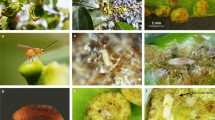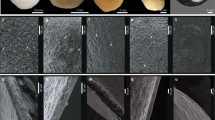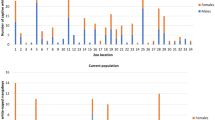Abstract
An isozyme study was conducted on a natural population of the solitary trap-nesting eumenid wasp, Ancistrocerus antilope (Panzer). The inbreeding coefficient was estimated to be 0.757 over seven loci from 322 diploid individuals collected from 108 trap nests. This inbreeding coefficient corresponds to a mixed-mating system with 91.3 per cent of matings occurring between brothers and sisters and the remaining matings occurring randomly. This is the highest inbreeding coefficient yet reported for a free-living Hymenopteran species. If such a high inbreeding level was present in the common ancestor of the Eumeninae and Vespinae, it may have facilitated the evolution of eusociality among the Vespinae.
Similar content being viewed by others
Article PDF
References
Breden, F, and Wade, M J. 1991. “Runaway” social evolution: reinforcing selection for inbreeding and altruism. J Theor Biol, 153, 323–337.
Carpenter, J M. 1982. The phylogenetic relationship and natural classification of the Vespoidea (Hymenoptera). Syst Entomol, 7, 11–38.
Carpenter, J M, and Cumming, J M. 1985. A character analysis of the North American potter wasps (Hymenoptera: Vespidae: Eumeninae). J Nat Hist, 19, 877–916.
Collins, J A, and Jennings, D T. 1987. Nesting height preferences of eumenid wasps (Hymenoptera: Eumenidae) that prey on spruce budworm (Lepidoptera: Tortricidae). Ann Entomol Soc Am, 80, 435–438.
Cooper, K W. 1953. Biology of eumenine wasps. I. The ecology, predation and competition of Ancistrocerus antilope (Panzer). Trans Am Ent Soc, 79, 13–35.
Cowan, D P. 1978. Behavior, Inbreeding, and Parental Investment in Solitary Eumenid Wasps (Hymenoptera: Vespidae). Ph.D Thesis, University of Michigan, Ann Arbor, MI.
Cowan, D P. 1979. Sibling mating in a hunting wasp: adaptive inbreeding? Science, 205, 1403–1405.
Cowan, D P. 1983. Hypothesis on cell provisioning in eumenid wasps. Biol J Linn Soc, 20, 245–247.
Cowan, D P. 1986. Sexual behavior of eumenid wasps (Hymenoptera: Eumenidae). Proc Ent Soc Washington, 88, 531–541.
Cowan, D P. 1991. The solitary and presocial Vespidae. In: Ross, K. G. and Matthews, R. W. (eds) The Social Biology of Wasps, pp. 33–73. Cornell University Press, Ithaca, NY.
Crozier, R H. 1971. Heterozygosity and sex determination in haplo-diploidy. Am Nat, 105, 399–412.
Danks, H V. 1983. Differences between generations in the sex ratio of aculeate Hymenoptera. Evolution, 37, 414–416.
Hamilton, W D. 1964. The genetical theory of social behaviour, I and II. J Theor Biol, 7, 1–52.
Hamilton, W D. 1967. Natural selection of unusual sex ratios. Heredity, 22, 163.
Hartl, D L. 1971. Some aspects of natural selection in arrhenotokous populations. Am Zool, 11, 309–325.
Herre, E A. 1985. Sex ratio adjustment in fig wasps. Science, 228, 896–898.
Krombein, K V. 1967. Trap-nesting Wasps and Bees: Life Histories, Nests, and Associates. Smithsonian Press, Washington, DC.
Kukul, P, and May, B. 1990. Diploid males in a primitively social bee, Lasiglossum (Dialictus) zephyrum (Hymenoptera: Halictidae). Evolution, 44, 1522–1528.
Laidlaw, H H, and Page, R E, JR. 1986. Mating designs. In: Rinderer, T. E. (ed.) Bee Genetics and Breeding, pp. 323–344. Academic Press, New York.
Longair, R W. 1981. Sex ratio variations in xylophilous aculeate Hymenoptera. Evolution, 35, 597–600.
Markert, C L, and Faulhaber, L. 1965. Lactate dehydrogenase isozyme patterns of fish. J Exp Zool, 159, 319–332.
Meizel, S, and Markert, G L. 1967. Malate dehydrogenase isozymes of the marine snail Ilyanassa obsoleta. Arch Biochem Biophys, 122, 753–765.
Michod, R E. 1980. Evolution of interactions in family-structured populations: mixed mating models. Genetics, 96, 275–296.
Mueller, U G, Eickwort, G C, and Aquadro, C F. 1994. DNA fingerprinting analysis of parent-offspring conflict in a bee. Proc Nat Acad Sci USA, 91, 5143–5147.
Packer, L, and Owen, R E. 1990. Allozyme variation, linkage disequilibrium and diploid male production in a primitively social bee Augochlorella striata (Hymenoptera; Halictidae). Heredity, 65, 241–248.
Petters, R M, and Mettus, R V. 1980. Decreased diploid male viability in the parasitic wasp, Bracon hebetor. J Hered, 71, 353–356.
Sokal, R R, and Rohlf, F J. 1981. Biometry, 2nd edn. Freeman, New York.
Strassmann, J E, Hughes, C R, Turillazzi, S, Sols, C R, and Queller, D C. 1994. Genetic relatedness and incipient eusociality in stenogastrine wasps. Anim Behav, 48, 813–821.
Waage, J K. 1982. Sib-mating and sex ratio strategies in scelionid wasps. Ecol Entomol, 7, 103–112.
Weir, B S, and Cockerham, C C. 1984. Estimating F-statistics for the analysis of population structure. Evolution, 38, 1358–1370.
Wilson, E O. 1975. Sociobiology. Harvard University Press, Cambridge, MA.
Author information
Authors and Affiliations
Rights and permissions
About this article
Cite this article
Chapman, T., Stewart, S. Extremely high levels of inbreeding in a natural population of the free-living wasp Ancistrocerus antilope (Hymenoptera: Vespidae: Eumeninae). Heredity 76, 65–69 (1996). https://doi.org/10.1038/hdy.1996.8
Received:
Issue date:
DOI: https://doi.org/10.1038/hdy.1996.8
Keywords
This article is cited by
-
Influence of reproductive biology on establishment capacity in introduced Hymenoptera species
Biological Invasions (2021)
-
Single locus complementary sex determination in Hymenoptera: an "unintelligent" design?
Frontiers in Zoology (2006)
-
Single-locus complementary sex determination in the inbreeding wasp Euodynerus foraminatus Saussure (Hymenoptera: Vespidae)
Heredity (2004)



